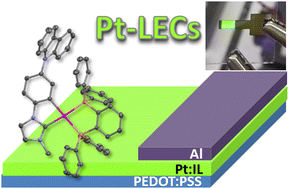Green light-emitting electrochemical cells based on platinum(ii) complexes with a carbazole-appended carbene ligand†‡
Abstract
Platinum(II) complexes bearing new carbazole-appended cyclometallated N-heterocyclic carbenes such as [Pt(Cbz-C^C*)Cl(NCCH3)](3), [Pt(Cbz-C^C*)Cl(PPh3)](4), [Pt(Cbz-C^C*)(PPh3)(py)]PF6 (py = pyridine, 5), [Pt(Cbz-C^C*)(P^N)]PF6 (P^N = 2-(2-(diphenylphosphino) ethyl) pyridine, 6), and [Pt(Cbz-C^C*)(P^P)]PF6 (P^P: 1,1-bis(diphenylphosphino)methane, dppm 7; 1,2-bis(diphenylphosphino)ethane, dppe, 8, 1,2-bis(diphenylphosphino) benzene, dppbz, 9) have been prepared using a stepwise procedure from 9-(4-bromo-phenyl)-9H-carbazole, imidazole, [{Pt(μ-Cl)(η3-2-Me-C3H4)}2] and the corresponding ancillary ligands. They have been fully characterized. Also, single-crystal X-ray structures, theoretical calculations and photophysical studies have been performed. These complexes have been employed as emitters in simple solution-processed light-emitting electrochemical cells (LECs). When driven under a pulsed current of 50 A m−2, devices based on 7–9 exhibited green emission, a luminance of 265 cd m−2 and a current efficiency of 5.7 cd A−1 (for the best performing emitter, 7). As far as we know, these are the first examples of green-emitting Pt(II)-based LECs.

- This article is part of the themed collections: 2023 Journal of Materials Chemistry Lectureship shortlisted candidates, Celebrating International Women’s Day: Women in Materials Science, Paul R. Raithby at 70: in celebration of a life in chemistry and 2022 Journal of Materials Chemistry C Most Popular Articles


 Please wait while we load your content...
Please wait while we load your content...